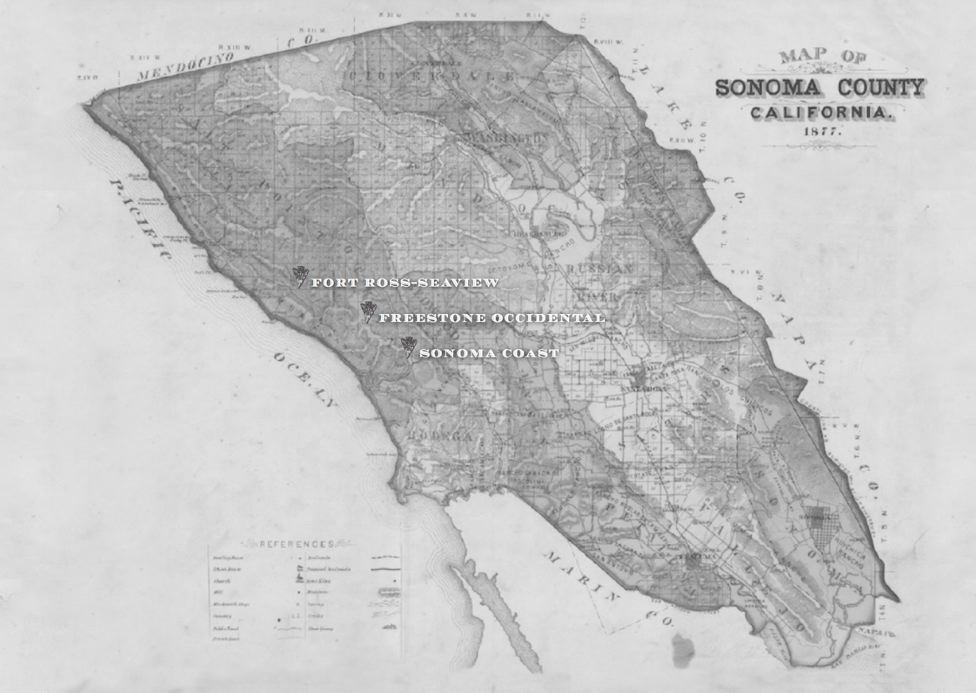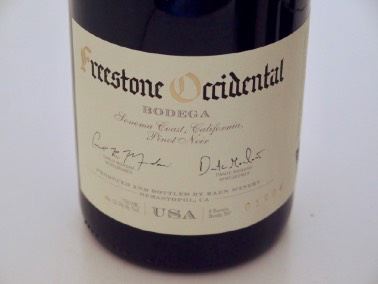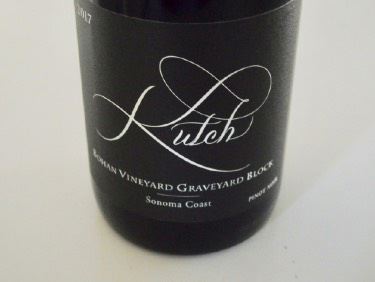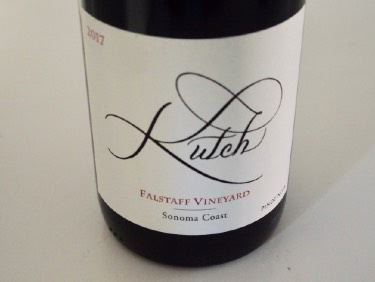Whole Cluster Inspired Sonoma Coast Wines from Kutch Wines & RAEN Winery
“I like to use whole clusters. I find it adds an extra dimension to the palate and aromas of a wine.”
Ted Lemon, Winemaker, Littorai
Regular readers of the PinotFile know that I have a special attraction to Pinot Noir crafted with a significant
amount of whole cluster. In winemaking, there are no universal approaches and this is what makes wine so
interesting, so variable in its expression and so endearing. Proponents of whole cluster fermentation so relish
the seductive, spicy, rose petal aromatics, the added flavors, and the soft, silky textures that they often pursue
100% whole cluster inclusion during vinification. Aromatics are the most challenging component of Pinot Noir to
capture and whole cluster fermentation can achieve haunting aromatics. Not only that, but older Pinot Noirs
made with a percentage of whole cluster can be more aromatically alive and complex. Whole cluster wines.
although containing more tannin, tend to be softer than de-stemmed wines due to the increase in pH that
stems produce and the contribution of partial carbonic maceration from whole berries.
From a consumer perspective, some New World palates do not find Pinot Noir wines made with significant
whole cluster inclusion to be appealing and prefer 100% de-stemmed wines. My counter-argument is many
completely de-stemmed Pinot Noir wines taste the same. Opponents of whole cluster wines complain about
the “veggie,” herbal, green tobacco, snap pea flavors that potentially can arise and be subtle or obvious. The
downside from a chemical winemaking perspective, as pointed out by winemaker Ted Lemon, is that stem
inclusion increases the pH and decreases the TA compared to a completely de-stemmed wine. “You may,
depending on region, vintage and ripeness at picking, have to acidify the resulting wine unless you are
comfortable with very high pHs.” (Ted Lemon uses a judicious percentage of whole cluster in his Pinot Noir
wines). Finally, there is the question of terroir and whether stylistic practices mask it or reveal it.
My advice is to line up some 100% whole cluster Pinot Noir wines from Kutch or RAEN or other producers with
some 100% de-stemmed Pinot Noir wines, all from the same region and vintage, and taste them blindly.
Decide for your self!
Both Kutch and RAEN Pinot Noir wines are fermented whole cluster and aged in neutral (no new) oak.
RAEN
RAEN (“rain”) is translated to Research in Agriculture and Enology Naturally. Winemakers Carlo and Dante
Mondavi give credit to their grandfather Robert and father Tim who were icons in the California wine business.
Tim’s passion for Pinot Noir was translated into an inspiration for Carlo and Dante at an early age. The winery
was launched with the 2013 vintage.
The winery’s Pinot Noirs come from two estate vineyards in the Sonoma Coast and an unnamed 10-acre
vineyard deemed “Sonoma Coast.”. Freestone Occidental Bodega is the coolest daytime site. Situated at 750
feet elevation, clones 667, Calera and Pommard are planted in Goldridge sandy loam. The Fort Ross-Seaview
Home Field Vineyard overlooks the Pacific Ocean north of Jenner. Grapes struggle here to ripen during the
growing season. Clone 777 is planted at an elevation of 1,025-1,270 feet. Soils are well-drained iron-rich
sandstone of the Franciscan series.
All of the 2017 grapes were picked, fermented and put into barrel before the tragic fires that swept through
Sonoma, Napa and Mendocino. RAEN vineyards remained untouched.
2017 was an ideal growing season on the Sonoma Coast. Stormy winter rains replenished the soils, streams
and lakes of California, ending five years of drought. The rains gave way to a beautiful spring and bud break
returned to a more historical norm. This was followed by a cool, even growing season until mid-August when a
series of heat waves arrived. These heat waves moved the final stages of ripening along rapidly. Overall, yields
at RAEN were slightly lower than historical averages.
The vintners recommend cellaring the wines for two years or if opened now, decant or open one hour prior to
pouring.
RAEN Pinot Noir is available through a mailing list and the RAEN Society Wine Club programs. Tasting is by
appointment. A Fort Ross-Seaview Chardonnay from the 35-year-old Charles Ranch is also available. Visit
www.raenwinery.com.

2017 RAEN Royal St. George Cuvée Sonoma Coast Pinot Noir
12.5% alc., $60. Named in
honor of Dante and Carlo Mondavi’s grandfather. A selection of the finest barrels giving a window
into the cool westerly hills of the true Sonoma Coast. Clones are Pommard, “828,” 667, Calera and
rVR1. Goldridge soils. Whole cluster, native fermentation. Aged in neutral French oak barrels.
Bottled without fining or filtration.
·
Moderately light garnet color in the glass. A whole cluster-driven
nose featuring aromas of cherry, pine sap and burnt tobacco. Very sleek, seamless and sexy, with a
mid weight core of black cherry fruit, accented with exotic spices. Good vibrancy and mellow
tannins, finishing intense and long with a dark cherry aromatic theme.
Score: 94

2017 RAEN Home Field Vineyard Fort Ross-Seaview Sonoma Coast Pinot Noir
13.0% alc.,
$80. The winery’s most westerly site, 4.8 acres located just under two miles from the Pacific Ocean.
Whole cluster, native fermentation. Aged in neutral French oak barrels. Bottled without fining or
filtration.
·
Moderate garnet color in the glass. Shy, but pleasing aromas of cherry and dark red
berries. Elegantly composed, with broad flavors of dark red and purple berries with just the right oak
and spice seasoning. Honed tannins and defining acidity fuel the harmony. The finish is gracious
and quenching.
Score: 94

2017 RAEN Bodega Vineyard Freestone Occidental Sonoma Coast Pinot Noir
12.7% alc., 200 cases, $90.
This vineyard sits just 4 miles from the coast. Surrounded by
redwoods, pines, wildflowers and coastal oaks. Whole
cluster, native barrel fermentation. Aged in neutral French
oak barrels. Bottled without fining or filtration.
·
Moderately
dark garnet color in the glass. Soaring aromas of fresh
cherry, bramble and rose petal. Long in the mouth with a bevy of black
cherry, boysenberry, earth and botanical flavors. Impeccably balanced
with a seductive finish that seems eternal.
Score: 95
Kutch Wines
I have written extensively in The PinotFile about the wines of Jamie Kutch. The wines have been on my
annual All-American team several years including 2018. Kutch Wines was one of my 2017 Wineries of the
Year: www.princeofpinot.com/article/2024/. The small production is sold through allocation to a mailing list
at www.kutchwines.com.
As you can see from the reviews, the wines in this vintage were all excellent, but the Falstaff Vineyard stood
out. Jamie’s comments about this vineyard provide insight and he prefaces a description of the vineyard and
growers as follows. “Sir John Falstaff was William Shakespeare’s fictional character, a fat knight who was vain,
boastful, cowardly and spent most of his time drinking at a bar while living on stolen or borrowed money.
Despite these unsavory characteristics, many scholars claim that Falstaff was one of Shakespeare’s greatest
creations alongside Hamlet and Cleopatra. So, what is so special about a drunken, gluttonous, lazy old man?
His appetite! Falstaff not only had a boundless appetite for food and wine but also for language, laughter,
people and life. It is these qualities that I share with Shakespeare’s grand character and hope to translate
through the wine that shares his name.”
Jamie gives considerable detail about Falstaff Vineyard, something few winemakers share. “Rudy and Judy
Lougheed purchased their 6-acre Falstaff Road property in 1999 with the intention of growing grapes. Ron, a
retired chemist, and Judy, a retired microbiologist were passionate wine lovers and had spent many weekends
in wine country exploring and imbibing. They planted 5.75 acres to Pinot Noir less than a year after they
purchased the property. At the time, there were no other vineyards on Falstaff Road, and now, two decades
later there are three, with a fourth likely to be planted soon.”
“The vineyard is located 8 miles inland from the Pacific Ocean, just outside the town of Sebastopol. Working
with Jim Pratt of Cornerstone Certified Vineyards, they chose to plant three clones of Pinot Noir: “828,” 115 and
777. The weather at the vineyard is considerably colder than Burgundy. Lougheed says, ‘If you want grapes at
25º Brix, you need to go elsewhere. This is a marginal site and ripening is tricky.” Falstaff is always the last
picked Pinot Noir vineyard for me each season and historically the smallest yielding (< 1 ton-per-acre at times). We have consulted with soil and viticulture scientist Dr Paul Skinner and instituted techniques to increase crop size and maximize phenolic ripeness.”
Jamie continues. “Ron and Judy Lougheed are the antitheses of Shakespeare’s Falstaff. They are humble,
thoughtful, and hard working. However, their appetite for growing high quality, great wine and enjoying it
alongside mushrooms they have foraged and homemade Pinot Noir jam undeniably harkens back to their
vineyard’s namesake. I am incredibly fortunate to work with them and their very special fruit.”
The growers:
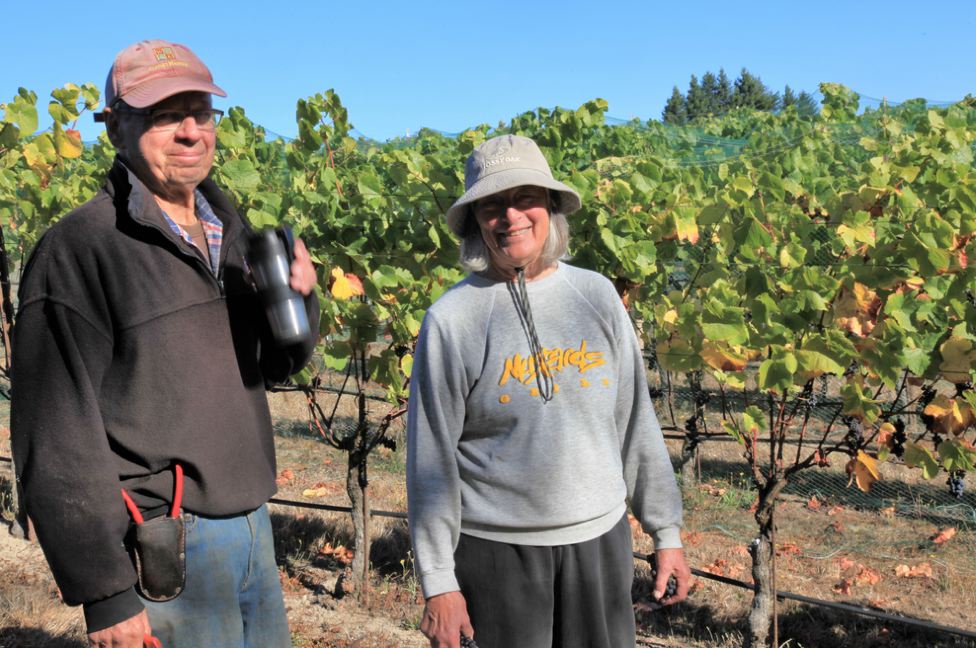
Jamie’s comments on the 2017 vintage. “2017 was the most compressed vintage of my career. We picked all
of our Pinot Noir in only 13 days. The season began with record-setting rainfall, which was much needed after
almost five years of drought. This abundance of rain delayed bud break and got the season off to a late start.
Soon enough, the skies across Sonoma County began to clear and sunny and warm conditions followed. As
flowering started, a variety of weather conditions kept growers on their toes. Late lifting fog, wind and unusual
heat spikes required careful attention and quick action in the vineyards. Canopy maintenance was also a top
priority as the early rains increased the plants’ vigor. Several heat spikes in June continued to drive canopy
growth and limited cluster size and weight. What looked like a potentially large crop on the vines turned out to
be average to just below average once the fruit was in the winery. August came and went somewhat
predictably, but early September brought extreme heat. Temperatures hung in the upper 90s to 100 degrees
setting off a fury of picking. McDougall Ranch was harvested August 28, Bohan Vineyard August 20, Bohan
Vineyard Graveyard Block September 2, Signal Ridge Vineyard September 7, and Falstaff Vineyard
September 9.”

2017 Kutch Sonoma Coast Pinot Noir
12.5% alc., 750 cases, $39. A blend of grapes from
McDougall Ranch, Bohan, Falstaff and Le Jons vineyards. Sandstone, Goldridge, Adobe clay and
sandy loam soils. 100% whole cluster, native yeast fermentation, fruit crushed and punched down
by foot, aged on the lees for 11 months in 100% neutral French oak barrels.
·
Moderate garnet color
in the glass. Complex nose displaying aromas of cherry, exotic spices, pine sap, tobacco smoke
and fertile earth. Excellent vim and vigor in a mid weight style with a gentle mouthfeel, offering
flavors of dark red cherry and berry and a subtle savory thread. Sporting the most whole cluster
character in the 2017 lineup, this wine is nicely balanced with submerged tannins. The fruit really sang when
tasted the following day from a previously opened and re-corked bottle. A terrific value.
Score: 91
2017 Kutch Signal Ridge Vineyard Mendocino Ridge Pinot Noir
12.0% alc., 150 cases, $52
The highest planted vineyard in all of Sonoma and Mendocino County at 2,800 feet. Located just north of the
Sonoma Coast AVA and south of the Anderson Valley AVA (essentially an extension of the true Sonoma Coast).
100% whole cluster, native yeast fermentation, fruit crushed and punched down by foot, aged on the lees for 11
months in 100% neutral French oak barrels.
·
Moderate garnet color in the glass. Love this nose. The aromas
are fresh and invigorating like a morning shower. Woodsy, with notes of fresh crushed grapes, darker red fruits
and spice. On the palate, the wine has plenty of charming energy, offering flavors of dark red and blue fruits
framed by ripe fine-grain tannins that are evident but not drying. Well-crafted with a notably persistent finish.
Still gorgeous, perfumed and easy to approach when tasted the following day from a previously opened and recorked
bottle.
Score: 93

2017 Kutch McDougall Ranch Sonoma Coast Pinot Noir
13.0% alc., 550 cases, $59.
This vineyard is located 3.5 miles from the Pacific Ocean at 935 feet elevation. Farm management
is by Ulises Valdez (RIP). Planted in 1998 to clone 114. Soils are Graywacke, sandstone. 100%
whole cluster, native fermentation, fruit crushed and punched down by foot, aged on the lees
without racking for 11 months in 100% neutral French oak barrels.
·
Moderate garnet color in the
glass. The aromas of dark cherry, burnt tobacco, woodland spice and bark really draw you into the
glass. Seamless in a mid weight style, with flavors of spiced dark red and purple fruits that dance
on the palate. More demure in this vintage, with cohesive tannins and an awesome finish displaying echos of
aromatic goodness. Superb in every way, and even a little more demonstrative when tasted the following day
from a previously opened and re-corked bottle.
Score: 95
2017 Kutch Bohan Vineyard Sonoma Coast Pinot Noir
12.0% alc., 300 cases, $54. George Bohan farms
original vines planted in 1972. The original vines are on their own rootstock and have been always dry farmed.
Located at 925 feet elevation, 3.1 miles from the Pacific Ocean on the second ridge inland. Sandstone soil.
100% whole cluster, native fermentation, fruit crushed and punched down by foot, aged on the lees for 11
months in 100% neutral French oak barrels.
·
Captivating aromatic display including pie cherry, strawberry,
underbrush, and a hint of burnt tobacco and root beer. Light to mid weight in concentration, offering spirited
flavors of cherry, strawberry and spice framed by noticeable, but engaging tannins. This wine is more aciddriven
with a modestly high strung, very lengthy finish. A little more lean and savory than the other Pinots in the
2017 lineup, but equally desirable. Even better when tasted the following day from a previously opened and recorked
bottle, and probably will be deserving of a higher score after a couple of years in bottle.
Score: 92

2017 Kutch Bohan Vineyard Graveyard Block Sonoma Coast Pinot Noir
12.9% alc., 100 cases, $Not released.
Sourced from a single block within the Bohan Vineyard.
Soils here are the rockiest on the ranch and create a distinct
wine. 100% whole cluster, native fermentation, aged 11
months without racking on the lees in 100% neutral French
oak barrels.
·
Light ruby red color in the glass. Aromas of
spiced cherry, turned earth and tobacco ash. Light to mid weight in an
elegant style, featuring well spiced red fruits with the slightest confected
tone. The rocky soil seems to give this wine a distinctive character that
defies my best efforts at description. There are noticeable, healthy
tannins that provide textural interest. But the most striking feature is the
impossibly long finish that is described as “fantastic” in my notes.
Considerably more enjoyable when tasted the following day from a previously opened and re-corked bottle
showing demonstrative aromas of spiced cherry, potpourri and sweet pipe smoke.
Score: 94

2017 Kutch Falstaff Vineyard Sonoma Coast Pinot Noir
12.5% alc., 350 cases, $64. The coldest site in the Kutch
vineyard lineup. Dijon “828,” 777 and 115 were planted in
2001 in marine quartz sandstone and Goldridge soil.
Vineyard is located at 550 feet elevation, 8.4 miles from the
Pacific Ocean on the second ridge inland. The berries are
often the size of peas and yields are below 1 ton-per-acre.
100% whole cluster, native fermentation, fruit crushed and punched
down by foot, aged 17 months on the lees with out racking in 100%
neutral French oak barrels.
·
Moderately dark garnet color in the glass.
The aromas of black cherry, blueberry, spice and sweet mulch really
soar over time in the glass. This is the kind of perfume you could dab
behind the ears for a pheromone effect. A wine of substance that
engages and caresses the palate with flavors of black cherry, blueberry,
savory herbs and tobacco. Modest, matching tannins and a really long and juicy finish. When tasted the
following day from a previously opened and re-corked bottle, the nose was dreamy and the overall impression
was harmony. I have been to the mountain top and it is good.
Score: 97



